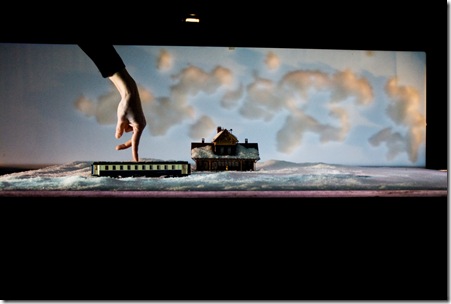Kiss and Cry: Tour de Force at Boston’s ArtsEmerson
Photo: Maarten Vander Abeele
ArtsEmerson recently hosted Kiss and Cry, an extraordinary intermedial production, which blends dance, puppetry, cinema, poetry, the recorded voice, and music – the whole in miniature. A Belgian collective creation, it is the brain child of dancer/choreographer Michèle Anne de Mey and her husband, cinema director Jaco Van Dormael, and developed in collaboration with the set designer, cameraman, image designer, and dancer Grégory Grosjean. Thomas Gunzig wrote the beautiful French script, here translated into English with the voiceover narration performed by Toby Regbo. His melodious voice suits the nostalgic quality of the fantastical love affair that he recounts.
Gisèle, a twelve year old girl, once briefly touched the hand of a boy in a stopped train. She becomes fixated on the boy’s hand and the thrill of that thirteen second encounter. Over her lifetime, seeking to retrieve the experience, she enters into five love affairs. Her feelings, romances, and memories are brought to life in a film created as the audience watches. Fittingly, the affairs are portrayed as dances performed by two pairs of hands. Frequently, the focus is on the fingers, which the dancers use as if they were legs. At moments, depending on the light, the tips of their fingers look as if they are wearing pointe shoes. These finger dances are balletic, sensual, achingly expressive, and occasionally funny.
The production is made up of two different worlds: a semi-darkened stage where the live and laborious action of executing the work takes place, and the large screen upstage where seemingly effortless aesthetic beauty emerges. At any moment, the spectator can switch attention from the stage to the screen. Both are fascinating. The whole cannot be viewed simultaneously.
Onstage are miniscule set pieces including a toy train and track, a rural train station, a dollhouse, and figurines. They are placed either on the floor or on tables. The performers, dressed in black, their bodies and faces obscured, are usually off to the side performing their hand dances, which observed at this angle are meaningless. Cameras, large and small, are moved about the stage capturing what is occurring, but through the dint of theatrical and cinematic techniques, all is transformed.
In keeping with the miniaturization of the piece, the ballets are brief, lasting only a few minutes at most. In one memorable scene, the dancers, bent over two fixed trapezes, push them back and forth with their fingers. All around are white bulbs like Christmas lights; a red parasol is behind them. Onscreen, we see full-sized trapezes and fingers as acrobats swinging gracefully in a starry, black sky. The parasol now evokes the image of a circus tent.
Recorded music, ranging in style from Handel, Vivaldi, Tchaikovsky, Gorecki, John Cage, Jacques Prévert, George Gershwin, and Prince, accompanies the images and narration as well as the dances. At times, the choreography interprets the lyrics and music literally as in Prévert’s Les feuilles mortes (Autumn Leaves). Leaves fall as the lovers go through the stages of their affair from passion to separation and loneliness – much of it danced on the beach described by Prévert.
The various sections are linked by the toy train, which, on the screen, moves through time and place, always returning to the station where Gisèle had her encounter. We see images of snow, desert, countryside. The lighting and devices, like the fog machine and the cameras placed in the train, create surrealistic effects. As it ends, the screen fades, the lights come up fully on the performers, and the human element is revealed as they embrace and dance their pas de deux. This show is pure magic.
Creative Team
Based on an original idea by Michèle Anne De Mey & Jaco Van Dormael
In collective creation with Grégory Grosjean, Thomas Gunzig, Julien Lambert, Sylvie Olivé, Nicolas Olivier
Directed by Jaco Van Dormael
Performed & Choreographed by Michèle Anne De Mey & Grégory Grosjean
Performed in English with the voice of Toby Regbo
Lighting – Nicolas Olivier
Images – Julien Lambert
Set – Sylvie Olivé
Sound Design – Dominique Warnier
